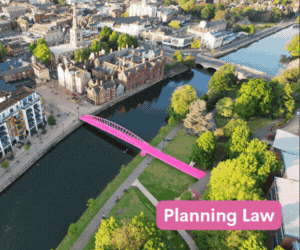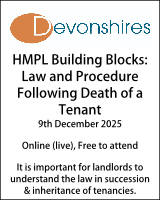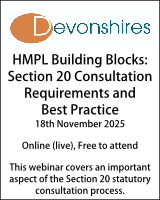Statements of case in housing disrepair claims
Jonathan McDonnell looks at the common issues that can arise when housing disrepair cases are not properly pleaded.
- Details
In a recent post on my blog, The Legal Position, I touched on the principle that a claim is limited to what is pleaded. In almost every trial I defend, the first step in preparing for trial is to examine the Particulars of Claim and disregard anything in the witness evidence that has not been properly pleaded.
This preliminary issue often arises because disrepair claims are sometimes treated as volume litigation. I have heard of Particulars of Claim being drafted in less than 15 minutes. Unsurprisingly, such pleadings often omit important items of disrepair. From a Claimant’s perspective, this can verge on professional negligence. Defendants, for their part, are also far more likely to fight a poorly pleaded case all the way to trial.
Generic or scattergun pleadings are equally problematic. A claim that pleads multiple causes of action for numerous items of disrepair but succeeds on only one will almost certainly invite the submission that the “true” winner is the Defendant.
The same criticisms apply to defences. Increasingly, I see generic pro forma defences which deny allegations made in the Particulars and simultaneously put the Claimant to proof, something that is conceptually and procedurally unsustainable. I also see Defendants admitting liability in pre-action correspondence, only to deny it later without applying to withdraw the admission under CPR r.14.1(2). Others rely on boilerplate assertions that the claim has not been properly pleaded, even where it plainly has.
Bottom line up front
Pleadings must be precise, clear and compliant with CPR Part 16. Claimants must avoid omissions and excessive detail, and Defendants must give careful, consistent responses and exercise real caution before alleging fraud. Poor drafting on either side wastes time, increases cost, and undermines the fairness of proceedings.
Particulars of Claim
CPR r.16.4(1) Particulars of claim must include – (a) a concise statement of the facts on which the Claimant relies.
The commentary within the White Book to this rule is helpful. In summary:
The Claimant should state all the facts necessary for the purpose of formulating a complete cause of action. A Claimant may also:
- Refer to any point of law on which their claim is based
- Give the name of any witness whom they propose to call
- Attach to or serve a copy of any document which they consider necessary to their claim
‘Concise statement of the facts’:
The commentary goes on to give two examples which are useful here:
In Hague Plant Ltd v Hague [2014] EWCA Civ 1609, the Claimant’s amended Particulars of Claim amounted to a ‘rambling and extensive’ sixty five page history of the alleged misdeed of the Defendant. Permission to amend was refused mainly on the ground that the draft pleading was disproportionate in the sense that it would not lead to litigation being conducted at proportionate cost.
In fairness, I am yet to see a set of Particulars of Claim that is rambling and extensive. The usual criticisms are that the Particulars of Claim:
- Do not fully plead the Claimant’s case in that items of disrepair have not been pleaded;
- Fail to plead causation in respect of damp and mould; and
- Plead various guidance notes that are not actionable in law.
The commentary goes on to note that reliance on multiple incidents or examples that do not advance the case overall is to be avoided. In Various Claimants v MGN Ltd [2020] EWHC 553 (Ch), Mr Justice Mann remarked at [59]: “A common sense judgment needs to be made in the light of what proportionality requires. If the Claimants make their case on a few, they do not need the rest. If they cannot make their case on their best few, the addition of more is unlikely to improve matters.”
In my view, this can apply directly to the allegations of notice. That said, I rarely see cases in which too many allegations of notice have been pleaded. Usually, the drafter has instead relied on a generic paragraph along the lines of ‘the Claimant has reported the disrepair on too many occasions to mention since 2019’.
The final note in the commentary that I want to focus on is extremely important. It reads ‘Concision in expressing the facts relied upon is not (or is rarely) achieved by mere cross-reference to contemporaneous correspondence.’ In other words, the Claimant cannot simply plead ‘to save time, the Claimant does not plead the disrepair, but relies on the contents of the expert report as if it was pleaded here in full.‘
What authorities can Defendants rely upon when faced with deficient Particulars of Claim?
Common authorities include:
Al-Medenni v Mars UK Ltd [2005] EWCA Civ 1041 per Dyson LJ
[21] – In my view the judge was not entitled to find for the Claimant on the basis of the third man theory. It is fundamental to our adversarial system of justice that the parties should clearly identify the issues that arise in the litigation, so that each has the opportunity of responding to the points made by the other. The function of the judge is to adjudicate on those issues alone. The parties may have their own reasons for limiting the issues or presenting them in a certain way. The judge can invite, and even encourage, the parties to recast or modify the issues. But if they refuse to do so, the judge must respect that decision. One consequence of this may be that the judge is compelled to reject a claim on the basis on which it is advanced, although he or she is of the opinion that it would have succeeded if it had been advanced on a different basis. Such an outcome may be unattractive, but any other approach leads to uncertainty and potentially real unfairness.
[22] – The starting point must always be the pleadings. In Loveridge and Loveridge v Healey [2004] EWCA Civ 173, Lord Phillips MR said this at para 23:
“In McPhilemy v Times Newspapers Ltd [1999] 3 All ER 775 Lord Woolf MR observed: ‘Pleadings are still required to mark out the parameters of the case that is being advanced by each party. In particular they are still critical to identify the issues and the extent of the dispute between the parties.’
It is on the basis of the pleadings that the parties decide what evidence they will need to place before the court and what preparations are necessary before the trial. Where one party advances a case that is inconsistent with his pleadings, it often happens that the other party takes no point on this. Where the departure from the pleadings causes no prejudice, or where for some other reason it is obvious that the court, if asked, will give permission to amend the pleading, the other party may be sensible to take no pleading point. Where, however, departure from a pleading will cause prejudice, it is in the interests of justice that the other party should be entitled to insist that this is not permitted unless the pleading is appropriately amended. That then introduces, in its proper context, the issue of whether or not the party in question should be permitted to advance a case which has not hitherto been pleaded.”
Skrzynski v The Commissioner of Police for the Metropolis [2014] EWCA Civ 9 per LJ Tomlinson:
[4] – Mr Browne did not follow up his objection by seeking a formal ruling on the question whether the case being run was open on the pleadings, so that is an end of the matter. Guidance as to how situations of this nature should be dealt with was given by Lawton LJ in Rolled Steel Products Holdings Limited v British Steel Corporation & Others [1986] 1 Ch 246 at 309-310:-
“I wish however to add a comment about the pleading points which have had to be considered in this appeal. From the way they were raised by counsel and dealt with by the trial judge, I was left with the impression that neither the judge nor defending counsel appreciated as fully as they should have done the need for precision and expedition when dealing with pleading points.
My recent experience in this court shows that some counsel and judges are not giving pleadings the attention which they should. Pleadings are formal documents which have to be prepared at the beginning of litigation, they are essential for the fair trial of an action and the saving of time at trial. The saving of time keeps down the costs of litigation. A plaintiff is entitled to know what defences he has to meet and the Defendant what claims are being made against him. If the parties do not know, unnecessary evidence may be got together and led or, even worse, necessary evidence may not be led.
Pleadings regulate what questions may be asked of witnesses in cross-examination. When counsel raises an objection to a question or a line of questioning, as Mr Morritt did on a number of occasions, the trial judge should rule on it at once. He should not regard the objection as a critical commentary on what the other side is doing. If the judge does not rule, counsel should ask him to do so. If a line of questioning is stopped because it does not relate to an issue on the pleadings, counsel should at once consider whether his pleadings should be amended. If he decides that they should, he should forthwith apply for an amendment and should specify precisely what he wants and the judge should at once give a ruling on the application. The principles upon which amendments should be allowed are well known and are set out in the current edition of the Supreme Court practice.”
Lambo v Lambo [2025] EWHC 2007 (Ch) per Deputy Master Glover:
[47] – As already indicated above, pleadings have an important function in assisting a court to understand a party’s case. They provide the court with a map and compass to the dispute before it. In addition, the discipline involved in properly pleading a case forces a party to consider how their case would be advanced at trial and the merits of that case before requiring the court to deploy its resources to resolve the matter. As is clear, this matter has not been progressed by way of a new claim form and pleadings, and it is far from clear that Patricia’s case has been subject to the anxious consideration that would ordinarily be expected
Common issues in disrepair cases
- The Claimant failing to plead all the disrepair for which they intend to rely – this is the most common issue and if it arises for the first time at trial, the Claimant has little hope of recovering from this position. This is easily avoided by the drafter carefully assessing the letter of claim and both expert reports (if there are two), and then carefully pleading what is relevant. I am not saying every allegation should be pleaded. If an expert does not support the Claimant’s claim, then a conversation ought to take place with the Claimant and advice given as to the merits and consequences of pleading an item of disrepair in which the prospects of success are less than 60%.
- The Claimant not pleading any specific dates of notice – if only a general year is given, it will depend on the Judge. I have seen some judges strike out claims pleaded in such a manner due to the Particulars of Claim lacking the specificity required for the Defendant to properly reply. In other cases, the Court has said ‘the Claimant is only relying upon the Defendant’s own records so how can the Defendant say that it does not know the case against it?’
- The Particulars of Claim missing a cause of action – the Claimant will be in great difficulties if they don’t plead, for example, that s.11 LTA 1985 applies.
- Not pleading the express terms of the agreement – again, this is Judge dependent. The express terms are often wider than the implied terms, so there is great value in pleading these correctly.
- The Claimant failing to plead causation in respect of damp and mould. I have seen entire cases struck out for this. Southwark London Borough Council v McIntosh [2001] All ER (D) 133 provides at:
[14]: ‘… All that is pleaded and all that is particularised is the damp of which complaint is made. The Claimant was evidently under the impression that it was sufficient to plead and prove the damp. This deficiency in the pleading had a lasting effect on the way the Claimant’s case was viewed by the experts and presented to and determined by the Judge. The Tenant’s expert clearly proceeded on the same basis as the pleading, namely that it was only necessary to establish the damp. He did not point to any damage to the structure or exterior of the premises: he did not address the question of causation of the damp: he regarded it sufficient to refer to the “water leaks”: see paragraph 5.3 of his report.’
[19] ‘But this assumes that the Landlord under section 11 had an obligation to investigate the cause of the damp and remedy it. There was however no pleaded duty to investigate and there could be no duty to investigate the cause of the damp or to remedy it unless the damp was caused by physical damage to the structure or exterior. The judge took the view (in effect) that the fact that the Tenant endured five years of damp was enough where there was no investigation of its cause and no cure by the Landlord. But that is not enough in law.’
[20] ‘… Further the experts cannot fill a lacuna in the Claimant’s Particulars of Claim in respect of pleading damage to the structure or exterior of the premises.’
In addition to these common issues, I recently had a case in which the Claimant’s counsel creatively submitted that the Defendant’s conduct in repeatedly completing minor repairs to the kitchen units were enough to show that the Defendant had assumed an obligation to repair the same. The Court found in favour of the Defendant in any event, but such an argument ought to be pleaded with precision.
What authorities can the Claimant rely upon when faced with a criticism that the Particulars of Claim have not been pleaded fully?
The recent Court of Appeal authority of Phones 4U Limited v EE Limited and Others [2025] EWCA Civ 869 provides some helpful guidance on new case theories:
186. In Al-Medenni there had been no application to amend and the “rather faint-hearted” espousal of the theory in closing submissions was far too late ([23]). The Defendants were denied the opportunity to explore the theory with the witnesses or to consider seeking evidence from others ([24]). Rather, the judge should have concluded that the claim was not proved. The judge had “crossed the line which separates adversarial and inquisitorial systems” ([25]).
187. Satyam Enterprises Ltd v Burton [2021] EWCA Civ 287, [2021] BCC 640 (“Satyam”) concerned the reverse situation of an unpleaded defence being adopted by the trial judge. There the claim advanced was that a former director and sole shareholder of the Claimant company had disposed of its assets at an undervalue. The Defendant defended the claim on the basis that there was no undervalue. He also pleaded that he had held the company’s shares on trust for a third party, a Mr Sharma. The judge dismissed the claim on the basis that the properties disposed of by the company were themselves held on trust for Mr Sharma, a proposition which had formed no part of either party’s case and was not raised at trial.
188. Nugee LJ, with whom Lewison and Arnold LJJ agreed, said at [36]:
“The present case … is not one of a party seeking to depart from his pleaded case, but one where the parties addressed in their evidence and submissions the cases that had been pleaded, but the judge decided the case on a basis that had neither been pleaded nor canvassed before him. In our system of civil litigation that is impermissible, and a misunderstanding of the judge’s function which is to try the issues the parties have raised before him…“
189. Nugee LJ then considered Al-Medenni before concluding that the course taken by the judge was not open to him, adding at [38]:
“Judges may sometimes think—and may even sometimes be right—that their own theory better fits the facts than that of either party, but if it is wholly outside the scope of the pleaded issues, that is nothing to the point, and to decide a case on a basis that has not been explored in evidence or addressed in submissions is likely to leave at least one, if not both, parties with a profound and justified sense of unfairness.”
190. Al-Medenni and Satyam were considered again in Ali v Dinc [2022] EWCA Civ 34. In that case the trial judge had reached a conclusion based on an “intermediate” combination of factual assertions from each party’s case, a combination which neither had expressly pleaded. The Defendants unsuccessfully appealed.
191. Birss LJ, with whom Green and Whipple LJJ agreed, added the following at [25] to what had been said in Al-Medenni and Satyam:
“These problems are all concerned with the interests of justice and, in particular, with circumstances which cause prejudice to the losing party. The common sort of prejudice which is to be avoided is that a new point has arisen in such a way that the losing party was not given a proper chance to call evidence or ask questions which could have addressed it. That is why the function performed by pleadings, lists of issues and so on, which is to give notice of and define the issues, is an important one; but is also why a judge can always permit a departure from a formally defined case where it is just to do so. It is also why the judge’s function is to try the issues the parties have raised before them, rather than to reach a conclusion on the basis of a theory which never formed part of either party’s case. By placing the emphasis on prejudice, the point I am making is that the modern approach to the definition of the issues requires judges to adopt a pragmatic approach in line with the overriding objective and not seek to be governed by unnecessary formality, provided always that it is just not to do so.”
192. In Ali v Dinc, the judge reached a decision on the pleadings that was open to her. Her conclusions were “composed entirely of the acceptance or rejection of factual assertions which were pleaded” ([29] and [30]). Further, in rejecting an argument from the appellants that the Claimant had narrowed the judge’s options by abandoning an alternative case, Birss LJ also observed that it could not be said that the appellants were ambushed or precluded from advancing submissions or evidence that they might otherwise have done: no prejudice had been identified ([34]).
193. Although the focus in Al-Medenni and Satyam was on the pleadings, Birss LJ’s comments make clear that the key determining factor is the interests of justice, and specifically the question of prejudice. So, for example, it could be that an uncanvassed theory advanced by a judge in relation to an important piece of evidence could be regarded as sufficiently unfair to warrant intervention by an appellate court, even though (being evidence rather than the facts necessary to establish a claim or defence) it did not form, or need not have formed, part of the pleadings. Conversely, I would not rule out the possibility of some departure from pleaded issues as not giving rise to unfairness on the particular facts of a case, although I would expect that to be rare unless the position was fully addressed at trial.
194. Drawing the threads together, I would summarise the position as follows:
a) The starting point is that a judge is not entitled to decide a case on a basis that has neither been pleaded nor canvassed before him. His function is limited to deciding the issues put before him.
b) Where, as in Al-Medenni and Satyam, a “theory” advanced by the judge is outside the scope of the pleaded issues (in the sense of the facts necessary to establish a claim or defence: Shagang Shipping at [98]), that will generally be a clear indication that reliance on that theory is impermissible.
c) However, the key point is the interests of justice and, in particular, the question of prejudice to the losing party.
d) This may mean that, even if an uncanvassed “theory” is not outside the scope of the pleaded issues, it would be unfair in all the circumstances of the case for the judge to rely on it. Conversely, in some cases it might not be unfair for the judge to depart from the scope of the pleaded issues, although generally only if this was fully addressed at trial.
195. It follows that I would not accept Mr Pickford’s submission of a “bright line” distinction between a departure from the pleaded issues and other evidence, the former being always impermissible. I would however agree that there is a spectrum, with cases of a wholesale departure from a pleaded case, as in Al-Medenni and Satyam, being at an extreme end of decision-making that will clearly be impermissible.
196. An analogy can be drawn with the approach that appellate courts take to raising new points on appeal, summarised by Lewison LJ in Hudson v Hathway [2022] EWCA Civ 1648, [2023] KB 345 at [34] and [35]. An appellate court will not generally permit a new point to be raised if it would necessitate new evidence or would have resulted in the trial being conducted differently with regards to the evidence. Further, even a new point of law may only be raised if (among other things) the other party has had adequate time to deal with it. However, there is a spectrum of cases and the just outcome will depend on an analysis of all relevant factors, including the question of prejudice.
197. As a general rule, judges should be very cautious about advancing a theory which has not been put forward by the parties. If it is outside the scope of the pleaded cases it should generally not be done at all: see above. If, short of that, a judge concludes that it is necessary to his decision to address such a theory in relation to any material evidence, the proper course is to raise it with the parties and to provide them with an adequate opportunity to make submissions about it, including as to whether further evidence is required to ensure a just outcome.
Another authority oft cited by Claimants in their Reply to Defence is the guidance provided by Lord Woolf in McPhilemy v Times Newspapers Ltd [1999] 3 All ER 775:
‘The need for extensive pleadings including particulars should be reduced by the requirement that witness statements are now exchanged. In the majority of proceedings identification of the documents upon which a party relies, together with copies of that party’s witness statements, will make the detail of the nature of the case the other side has to meet obvious. This reduces the need for particulars in order to avoid being taken by surprise. This does not mean that pleadings are now superfluous. Pleadings are still required to mark out the parameters of the case that is being advanced by each party. In particular they are still critical to identify the issues and the extent of the dispute between the parties. What is important is that the pleadings should make clear the general nature of the case of the pleader…’
‘As well as their expense, excessive particulars can achieve directly the opposite result from that which is intended. They can obscure the issues rather than providing clarification. In addition, after disclosure and the exchange of witness statements pleadings frequently become of only historic interest. Although in this case it would be wrong to interfere with the decision of Eady J, the case is overburdened with particulars and simpler and shorter statements of case would have been sufficient. Unless there is some obvious purpose to be served by fighting over the precise terms of a pleading, contests over their terms are to be discouraged. In this case the distinct impression was given by the parties that both sides were engaged in a battle of tactics. Each side was seeking to fight the action on, what from that party’s perspective appeared to be, the most favourable ground. The dispute over particulars was just being used as a vehicle for that purpose.
If disputes of the nature which have occurred in this case are necessary, they should certainly not be dealt with in isolation. They should be dealt with at hearings where all the outstanding issues are resolved. I regret that it seems all too likely that in this case the decision on this appeal will be followed rapidly by a further bitterly fought interlocutory skirmish over the question of whether the case should be heard by a judge alone or a judge sitting with a jury. The Defendants’ delay in seeking leave may have contributed to the need for the additional hearing. However, proper case management by the parties required the consolidation of the three hearings. At a case management hearing, instead of a sterile argument as to whether a particular fact should or should not be pleaded as a particular of justification, if necessary and desirable the issues to be decided at the trial could, failing agreement, have been identified by the court and a decision taken as to what evidence would be appropriate for this purpose.’
What about the Defence?
CPR r.16.5 provides:
16.5—(1) In the defence, the Defendant must deal with every allegation in the particulars of claim, stating—
(a)which of the allegations are denied;
(b)which allegations they are unable to admit or deny, but which they require the Claimant to prove; and
(c)which allegations they admit.
(2) Where the Defendant denies an allegation—
(a)they must state their reasons for doing so; and
(b)if they intend to put forward a different version of events from that given by the Claimant, they must state their own version.
(3) If a Defendant—
(a)fails to deal with an allegation; but
(b)sets out in the defence the nature of their case in relation to the issue to which that allegation is relevant,
the Claimant is required to prove the allegation.
…
(5) Subject to paragraphs (3) and (4), a Defendant who fails to deal with an allegation shall be taken to admit that allegation.
Again, the commentary to the White Book provides useful information which is similar to that set out above. Rule 16.5(1) raises a positive duty for a Defendant to admit or deny pleaded allegations where he or she is able to do so and so to prevent merely “a stonewalling defence full of indiscriminate non-admissions” (per Lord Justice Henderson in SPI North Ltd v Swiss Post International (UK) Ltd [2019] EWCA Civ 7 at [48].
Denials must be explicit; the Defendants must state their reasons for denying the allegation and, if they intend to put forward a different version of events from that given by the Claimant, they must state their own version (r.16.5(2)). Similarly, if they dispute the statement of value included in the claim form they must state why they dispute it and, if they are able, give their own statement of the value of the claim (r.16.5(3)).
A Defendant wishing to challenge the whole or part of a claim on the basis that it is fraudulent must include, in their defence, particulars of the primary facts relied on as proof of fraud.
A breach of r.16.5 is committed if the Defendant puts the Claimant to proof merely because the Defendant is unwilling to admit an allegation.
Allegations which are admitted cease to be in issue between the parties and the Claimant is not required to prove them.
Common issues with Defences
- The statement of truth not signed by someone with authority to do so – Practice Direction 22, paragraph 3.1 is clear. In my view, housing officers ought not to be signing Defences.
- The difference between putting the Claimant to proof and denying an allegation – this is all too common. It is usually along the lines of ‘paragraph x is denied and the Claimant is put to proof.’ Having considered the rules above, I hope that it is obvious that this is not permitted by the rules. If the Defendant denies an allegation, it needs to say why. This is conceptually different from simply asking the Claimant to prove it. The following extract from Aven & Ors v Orbis Business Intelligence Ltd [2020] EWHC 523 (QB) is relevant: ‘The general principles are clear: it is open to a Defendant to require a Claimant to prove their pleaded case by means of a non-admission, or alternatively to deny the pleaded case. The problem, or part of the problem, in the present case stems from the fact that this Defendant has done both. A denial by its nature goes beyond a non-admission.‘
- Disrepair litigation, in my view, has developed a strange culture in that the litigants can be quite terse with one another. Sometimes, however, Defendants go too far and allege that different aspects of the claim are ‘misleading the Court’. Accusing the Claimant, or their representatives, of misleading the Court, or of being dishonest, is a serious allegation to make. There are regulatory requirements in place which restrict when counsel are permitted to plead such allegations. Unfortunately, these are routinely ignored. There is a difference between the Claimant being wrong, or being unable to prove something, and instead being misleading. Failing to prove an allegation of fraud can result in the Court awarding indemnity costs against the accuser. If the Defendant is willing to accuse the Claimant of being fraudulent in a public forum, they may need to pay the consequences if they then fail to prove such a strong accusation.
Conclusion
Drafting pleadings really is a skill that improves with time. In my view, care and attention ought to be given to each case to ensure that the case is pleaded as well as it can be. This applies to both Claimants and Defendants. Properly pleaded cases will ultimately save time and costs.
A significant part of my practice is spent drafting pleadings in disrepair matters. If you want to instruct me, please contact the clerks using the information below.
Jonathan McDonnell is a barrister at Park Square Chambers. This article first appeared on his blog, The Legal Position.
22-10-2025 4:00 pm
05-11-2025 4:00 pm

























